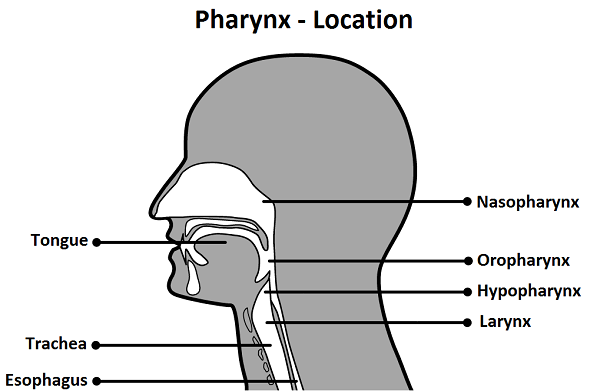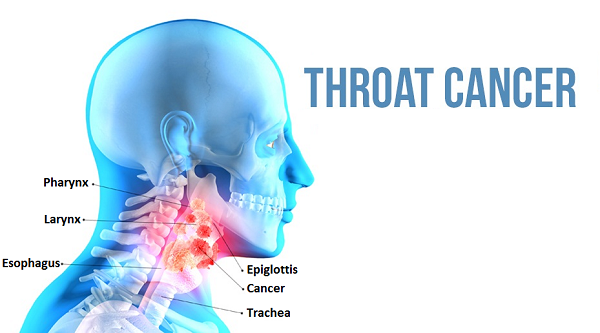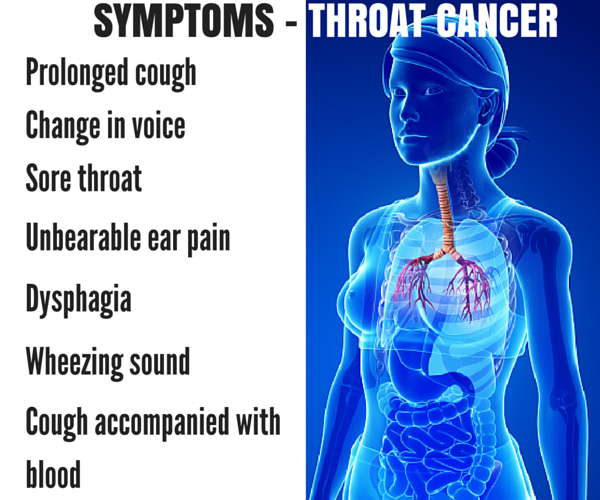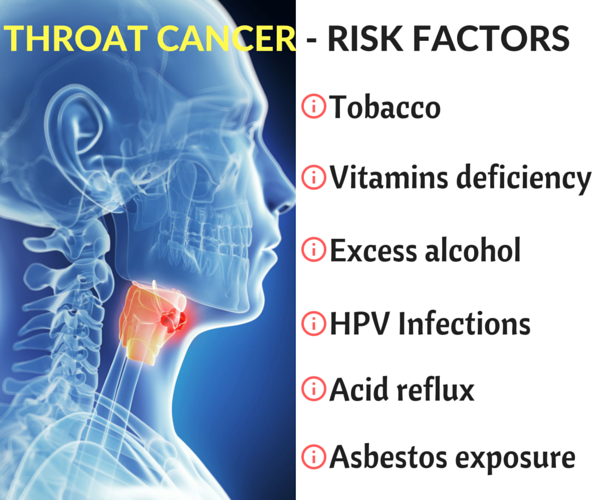Throat cancer refers to the condition where cancerous cell development takes place anywhere in or around the voice box, vocal cords, oropharynx or tonsils. Depending on the area of cancer growth, throat cancer has been divided into two types – Laryngeal Cancer relating to Larynx and Pharyngeal Cancer relating to Pharynx.
Larynx is what is commonly known as Voice box and houses the vocal cords, that facilitate speech and singing. It is located in the mid line of throat, deep within the skin.
Pharynx is the long tube running behind the mouth and nose, performing two essential functions. Pharynx transfers food from mouth to esophagus and also filters, warms and moistens the air we breathe, so as to conduct the same to the lungs. Thus, pharynx forms an essential part of both are digestive and respiratory system.
Cancers in this area are definitely quite painful. However, the good news is that, accurate treatment and medical procedures administered in a timely manner allow patients to recover and thus survive for several more years.
Preventing throat cancer by bringing about some changes in our life style is the best way you could keep away from painful symptoms it can bring about. In addition, knowing early signs can also help from controlling the disease from getting worse.
Symptoms of Throat Cancer – Initial to Acute:
- Constant and prolonged cough
- A need to clear your throat repeatedly after short duration
- A feeling that something is stuck in the throat
- Dysphagia – a condition that involves difficulty in swallowing
- Change in voice or hoarseness
- Stridor – Wheezing sound indicating narrowed airway
- Sore throat
- Swollen lymph nodes in the neck
- May lead to sudden weight loss
- Cough accompanied with blood
- Unbearable ear pain
- Swelling around the eyes, jaw and neck
- Rarely, it may lead to difficult breathing
Throat Cancer – Causes and Risk Factors:
Men are two to three times more prone to throat cancers. The exact reasons that cause cells in your throat to multiply uncontrollably, that do not die and thereby lead to throat cancer, still remain unknown. However, below are some of the risk factors that make you more susceptible to throat cancer and also aggravate existing symptoms if any:
- Use of tobacco: Cigarettes, pipes cigars and betel nuts are considered as one of the prime triggers of throat cancer. These make people ten times more susceptible to cancers related to throat or any other form of cancers.
- Alcohol consumption is equally detrimental: Similar to tobacco, alcohol can also put you to greater risk of suffering from throat cancer.
- Deficiency of essential Vitamins : A poor diet that lacks essential vitamins has also been listed as one of the primary reasons of throat cancer, because such deficiencies reduce body’s natural immunity. Therefore, including food items such as; fish, green leafy vegetables, nutritious fruits, sweet potatoes, etc. can help you meet Vitamin requirements of your body.
- Asbestos exposure: Asbestos that proves very useful for industrial purposes has been marked as one of the notorious triggers of throat cancer. It has also been listed to cause another very serious and rare cancer known as Mesothelioma that has been discussed in one of our earlier posts.
- HPV infections: Human papillomavirus infection(HPV) is a sexually transmitted virus that is known to cause Cervical cancer in women. Recent research shows that HPV can also cause throat cancers.
- Epstein Barr Virus(EBV) infections: A type of virus that has been related to throat cancer.
- GERD – Acid Reflux: A condition may arise where acid may leak into esophagus from stomach. This is known as acid reflux, which in the acute form is called Gastroesophageal Reflux Disease(GERD). If this condition is left undiagnosed and untreated, it can cause throat cancer in later stages.
Besides, any other form of cancer relating to lungs and related area may also spread to the throat.
Throat Cancer and its types:
As mentioned earlier, throat cancers have been divided into two categories; that further get divided into different subsections. You can get a brief idea about these in this section:
Laryngeal Cancer:
Larynx contains the vocal cords that produce speech and sound. It has been divided into three parts – Supraglottis, glottis and subglottis. All of these parts have equal chances of developing cancerous cells.
Laryngeal cancers have been related to two type of cells. Squamous cell carcinoma involve flat scale cells that line the throat. This is more common as compared to the other form known as adenocarcinoma, that involves glandular cells of larynx that produce mucous.
Pharyngeal Cancer:
Pharyngeal Cancer has been divided into three types explained below:
- Nasopharynx Cancer: Upper part of the throat that lies just behind your nose is known as nasopharynx. The air that we breathe in, passes through nostrils and reaches nasopharynx where it gets filtered and then reaches the lungs. EBV has been marked as one of the greatest triggers causing cancer in Nasopharynx.

- Oropharynx: The middle part of throat is known as the Oropharynx and includes base of tongue, tonsils, soft palate and walls of pharynx. Oropharyngeal Cancer can again be divided into two types based on the reasons causing it. The first is Human Papillomavirus positive and relates to HPV infection explained above. The second is Human Papillomavirus negative and relates to other miscellaneous reasons such as tobacco use, smoking etc.
- Hypopharynx: The bottom part of throat is known as the Hypopharynx and it is here that the larynx meets the esophagus. Hypopharyngeal cancer is the most difficult of all cancers with lowest survival rates. Primary causes include; smoking and excessive use of tobacco. This type of cancer is difficult to be diagnosed at an early stage as it does not show any vivid symptoms. And this is what makes it one of the deadliest of all.
Diagnosing Throat Cancer – Lab Exams and Tests:
The following are few of the very common laboratory examinations to diagnose throat cancer.
- Endoscopy and Laryngoscopy:
During this procedure, your doctor will insert a scope into your throat that is fitted with a camera. The lighted scope is known as endoscope and hence the procedure is called endoscopy.
A similar procedure where a different type of scope, known as laryngoscope is used to examine deep inside your vocal cords, and the procedure is hence known as laryngoscopy. Both these procedures are similar and detect abnormalities in the form of images that are visible in a monitor connected to the scope.
- Imaging Tests:
The following are the imaging tests used in throat cancer detection:
- Computerised Tomography or CT Scans
- Magnetic Resonance Imaging or MRI Scans
- Positron Emission Tomography or PET Scans
- Ultrasound Scan
Besides these, your doctor may prescribe different diagnostic tests to route your throat cancer causes and then determining the treatment procedures.
Biopsy:
Depending upon your endoscopy results, your doctor may conduct a biopsy if any abnormality is suspected. This procedure involves removing a small segment of the infected tissue for further laboratory testing.
Laryngeal and Pharyngeal Cancer – Staging and Treatment:
Diagnostic procedures are immediately followed with staging. Any person who is diagnosed with throat cancer is naturally worried if the disease can get fatal leading to early death. Staging can provide patients an understanding of their health condition and an insight to treatments and survival rates.
Throat cancer at a later stage is difficult to treat; however, continuous and effective treatment can increase survival rates.
Throat cancer similar to other cancers also has four different stages; starting from Stage 0 to Stage 4. Early stages are easier to treat as compared to later stages. However, early stages do show acute symptoms and thus remain undiagnosed. It is for this reason that physicians always suggest people to undergo periodic health checkups that facilitate early detection of underlying ailments.
Laryngeal Cancer Treatment based on Stages:
Stage 0: Laryngeal cancer at stage 0 is easily treated and cured. Laser Surgery and Radiation Therapy are the two most common treatment procedures that are carried out. Vocal stripping is also another treatment option widely used for getting rid of cancers at early stage. In cases where cancerous cells reappear after treatment, radiation therapy can again be administered.
Stage 1 and 2: Most patients are diagnosed with laryngeal cancers at stages 1 and 2. Treatment options such as radiation or partial laryngectomy are the most common ones. This surgery involves careful removal of infected sections of larynx that cause minimum or no harm to your vocal cords. However, a speech therapy after surgery is always suggested.
Stage 3 and 4: Chemotherapy, along with radiation and surgery are used to treat cancers in stages 3 and 4. Surgery involves total removal of larynx and lymph nodes. Several therapies post surgery are mandatory to help patients get back to close to normal speaking abilities.
Pharyngeal Cancer Treatment based on Stages:
Stage 0: Pharyngeal cancers that have been diagnosed at a very early stage can be treated with radiation therapies and do not call for surgeries. Tumor structures detected can easily be removed during biopsies and small resections.
Stage 1 and 2: Surgical resections and definitive radiation therapies are used for treating cancers at these stages.
Stage 3 and 4: Chemotherapy and surgical removal are greatly carried to treat these advanced stages of throat cancer. Besides, induction therapies are also used on patients who are not suitable for surgical treatments.
Survival Rates Post Diagnosis:
Cancers of any form have 5 years assessing plan. This implies that patients are examined and treated to check if they have chances of surviving 5 years post diagnosis. However, effective treatments can help patients survive much more than 5 years.
Laryngeal cancers detected at stage 0 and 1 have 90% chances of surviving 5 years post diagnosis. Stages 2 and 3 have 75% to 55% survival rates respectively. Stage 4 on the other hand has lowest survival rates accounting to only 30% to 40%.
Oropharyngeal cancers detected at an early stage has 5 year survival rates of around 80%. As the cancer progresses to further stages, survival rates fall. Nasopharyngeal cancers at an early stage have 5 year survival rate of around 70 – 72 percent. However, later stages can have survival rates of only 38%. Finally, Hypopharyngeal Cancers at an early stage have 5 year survival rate of around 53%.
Thus, throat cancers do not have very high chances of total cure. Not many patients get detected with throat cancers at an early stage when cancers are not malignant, because early symptoms are subtle and easy to ignore. However, being a little cautious regarding your own health can help you prevent these dreadful and fatal diseases. In addition, learning about early symptoms and abstaining from vital triggers can help you prevent these diseases.
Lastly, take your first step and say No to tobacco, smoke and alcohol and say No to throat cancer.



